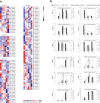Comprehensive analysis of the longan transcriptome reveals distinct regulatory programs during the floral transition
- PMID: 30744552
- PMCID: PMC6371577
- DOI: 10.1186/s12864-019-5461-3
Comprehensive analysis of the longan transcriptome reveals distinct regulatory programs during the floral transition
Abstract
Background: Longan (Dimocarpus longan Lour.) is an important fruit tree in the subtropical regions of Southeast Asia and Australia. Among the factors affecting D. longan fruit yield, the difficulty and instability of blossoming is one of the most challenging issues. Perpetual flowering (PF) is a crucial trait for fruit trees and is directly linked to production potential. Therefore, studying the molecular regulatory mechanism of longan PF traits is crucial for understanding and solving problems related to flowering. In this study, comparative transcriptome analysis was performed using two longan cultivars that display opposite flowering phenotypes during floral induction.
Results: We obtained 853.72 M clean reads comprising 125.08 Gb. After comparing these data with the longan genome, 27,266 known genes and 1913 new genes were detected. Significant differences in gene expression were observed between the two genotypes, with 6150 and 6202 differentially expressed genes (DEGs) for 'SJ' and 'SX', respectively. The transcriptional landscape of floral transition at the early stage was very different in these two longan genotypes with respect to key hormones, circadian rhythm, sugar metabolism, and transcription factors. Almost all flowering-related DEGs identified are involved in photoperiod and circadian clock pathways, such as CONSTANS-like (COL), two-component response regulator-like (APRRs), gigantea (GI), and early flowering (EFL). In addition, the leafy (LFY) gene, which is the central floral meristem identity gene, may inhibit PF formation in 'SJ'.
Conclusion: This study provides a platform for understanding the molecular mechanisms responsible for changes between PF and seasonal flowering (SF) longan genotypes and may benefit studies on PF trait mechanisms of evergreen fruit trees.
Keywords: Comprehensive transcriptome analysis; Floral transition; Longan; Perpetual flowering.
Conflict of interest statement
Ethics approval and consent to participate
Not applicable.
Consent for publication
Not applicable.
Competing interests
The authors declare that they have no competing interests.
Publisher’s Note
Springer Nature remains neutral with regard to jurisdictional claims in published maps and institutional affiliations.
Figures







Similar articles
-
Genome-wide identification of CONSTANS-like genes in Dimocarpus longan and functional characterization of DlCOL9 revealing its role in floral induction.Plant Physiol Biochem. 2025 Aug;225:110017. doi: 10.1016/j.plaphy.2025.110017. Epub 2025 May 12. Plant Physiol Biochem. 2025. PMID: 40381360
-
Identification of WRKY Gene Family from Dimocarpus longan and Its Expression Analysis during Flower Induction and Abiotic Stress Responses.Int J Mol Sci. 2018 Jul 25;19(8):2169. doi: 10.3390/ijms19082169. Int J Mol Sci. 2018. PMID: 30044387 Free PMC article.
-
Integrative mRNA and Long Noncoding RNA Analysis Reveals the Regulatory Network of Floral Bud Induction in Longan (Dimocarpus longan Lour.).Front Plant Sci. 2022 Jun 14;13:923183. doi: 10.3389/fpls.2022.923183. eCollection 2022. Front Plant Sci. 2022. PMID: 35774802 Free PMC article.
-
Floral Induction of Longan (Dimocarpus longan) by Potassium Chlorate: Application, Mechanism, and Future Perspectives.Front Plant Sci. 2021 Jun 7;12:670587. doi: 10.3389/fpls.2021.670587. eCollection 2021. Front Plant Sci. 2021. PMID: 34163509 Free PMC article. Review.
-
[Regulation network and biological roles of LEAFY in Arabidopsis thaliana in floral development].Yi Chuan. 2004 Jan;26(1):137-42. Yi Chuan. 2004. PMID: 15626683 Review. Chinese.
Cited by
-
Comparative Analysis of the MADS-Box Genes Revealed Their Potential Functions for Flower and Fruit Development in Longan (Dimocarpus longan).Front Plant Sci. 2022 Jan 27;12:813798. doi: 10.3389/fpls.2021.813798. eCollection 2021. Front Plant Sci. 2022. PMID: 35154209 Free PMC article.
-
Decoding Gene Expression Signatures Underlying Vegetative to Inflorescence Meristem Transition in the Common Bean.Int J Mol Sci. 2022 Nov 26;23(23):14783. doi: 10.3390/ijms232314783. Int J Mol Sci. 2022. PMID: 36499112 Free PMC article.
-
Isolation and Functional Characterization of a LEAFY Gene in Mango (Mangifera indica L.).Int J Mol Sci. 2022 Apr 2;23(7):3974. doi: 10.3390/ijms23073974. Int J Mol Sci. 2022. PMID: 35409334 Free PMC article.
-
Chlorate-induced molecular floral transition revealed by transcriptomes.Open Life Sci. 2023 Jul 29;18(1):20220612. doi: 10.1515/biol-2022-0612. eCollection 2023. Open Life Sci. 2023. PMID: 37528883 Free PMC article.
-
Transcriptomic Profiling of Buds Unveils Insights into Floral Initiation in Tea-Oil Tree (Camellia oleifera 'changlin53').Plants (Basel). 2025 Jul 30;14(15):2348. doi: 10.3390/plants14152348. Plants (Basel). 2025. PMID: 40805697 Free PMC article.
References
-
- Matsumoto TK. Genes uniquely expressed in vegetative and potassium chlorate induced floral buds of Dimocarpus longan. Plant Sci. 2006;170(3):500–510. doi: 10.1016/j.plantsci.2005.09.016. - DOI
-
- Wu YL, Yi GJ, Zhou BR, Zeng J, Huang YH. The advancement of research on litchi and longan germplasm resources in China. Sci Hortic. 2007;114(3):143–150. doi: 10.1016/j.scienta.2007.07.016. - DOI
-
- Zhang HN, Shi SY, Li WC, Shu B, Liu LQ, Xie JH, Wei YZ. Transcriptome analysis of ‘Sijihua’ longan (Dimocarpus longan L.) based on next-generation sequencing technology. J Hortic Sci Biotechnol. 2016;91(2):180–188. doi: 10.1080/14620316.2015.1133539. - DOI
MeSH terms
Substances
Grants and funding
- 31572087/National Natural Science Foundation of China
- CARS-32-02/China Litchi and Longan Industry Technology Research System
- 1630062019014/Central Public-interest Scientific Institution Basal Research Fund for Chinese Academy of Tropical Agricultural Sciences
- 317243/Natural Science Foundation of Hainan Province
- 201604020188/the Science and Technology Program of Guangzhou
LinkOut - more resources
Full Text Sources

